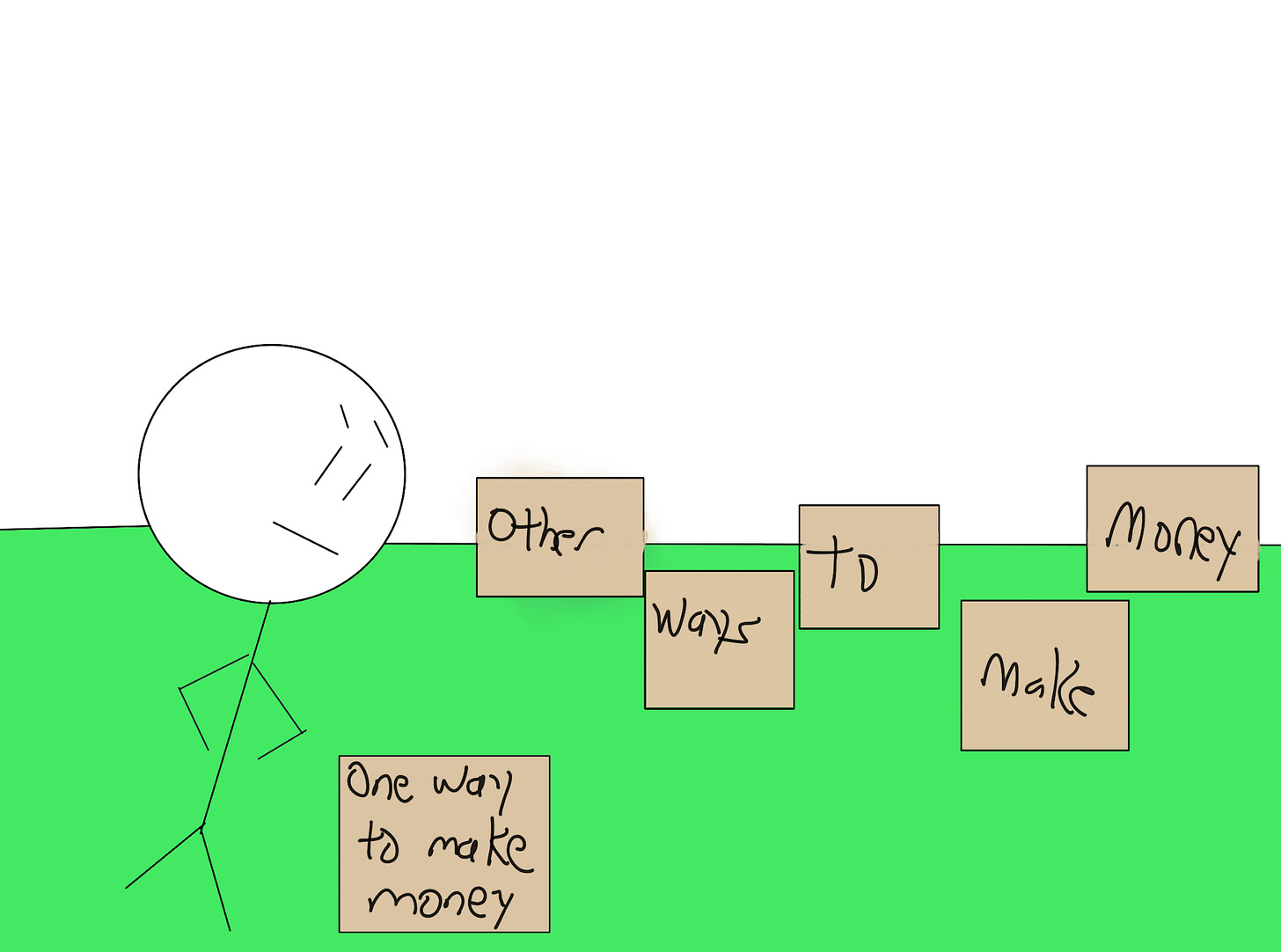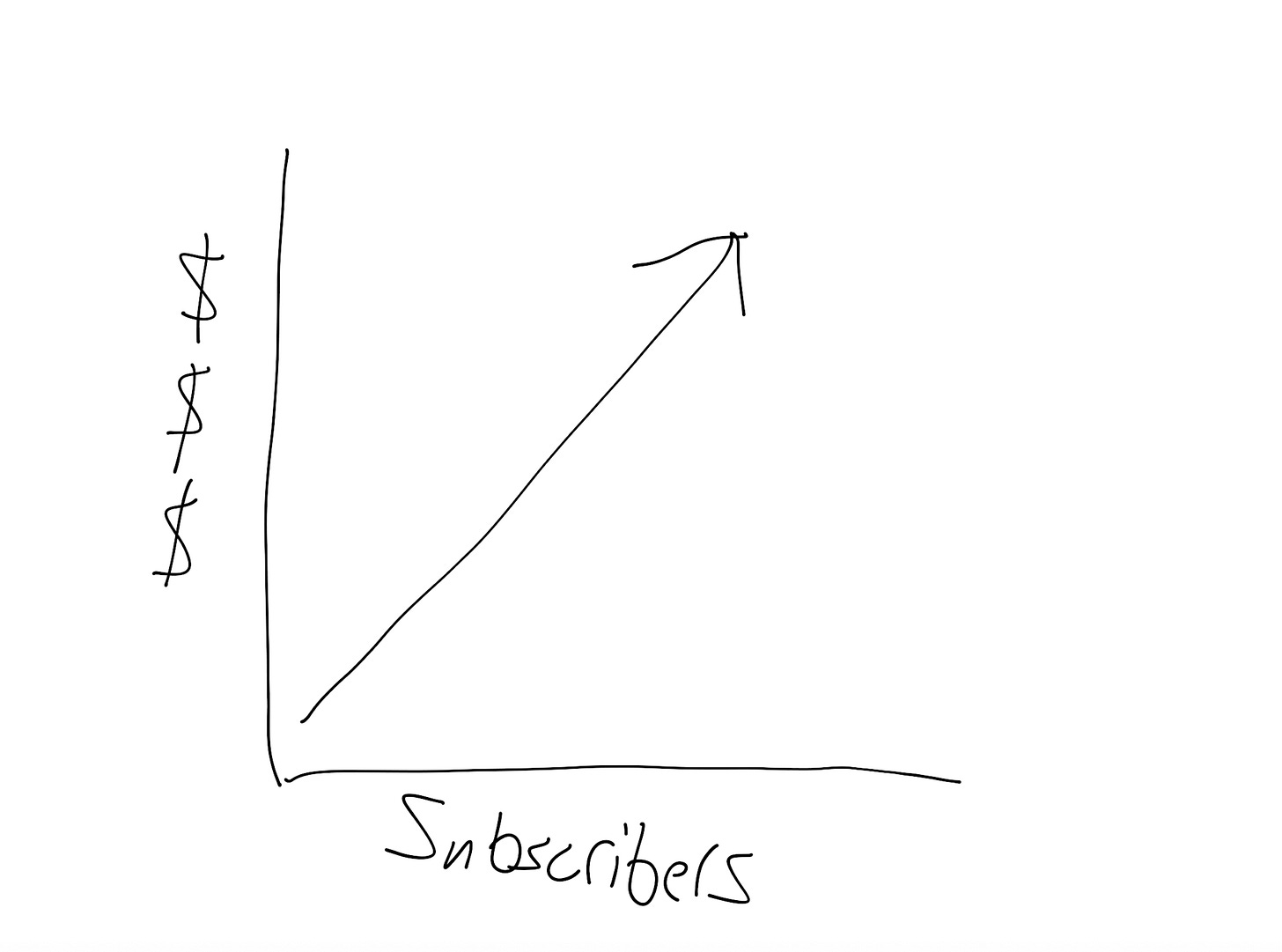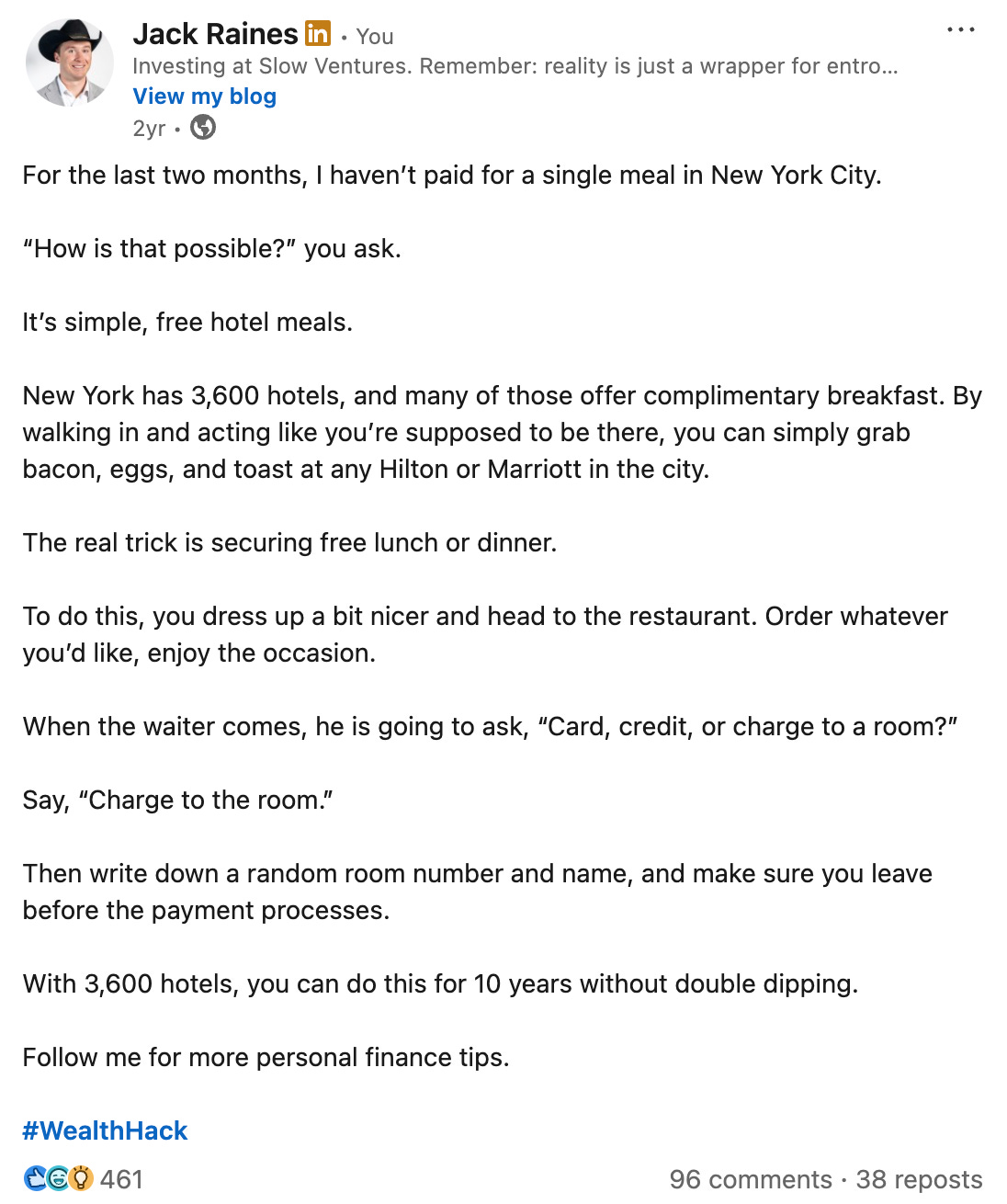What Are You Optimizing For?
On separating the means from the ends and avoiding the inertia trap.
Welcome to Young Money! If you’re new here, you can join the tens of thousands of subscribers receiving my essays each week by adding your email below.
“50,000 subscribers. That’s all I need for $250,000 a year. 50,000 subscribers.”
In 2022, I had a very simple plan for the rest of my life. At the time, I was running advertising partnerships and editing a finance newsletter with ~150,000 subscribers, and we were charging thousands of dollars per day for our ad slots. At the same time, I had just hit the 10,000 subscriber mark on Young Money, and I was selling advertisements for $1,000 a pop on my newsletter.
My open rate was strong, advertisers were happy with the click-through rates on their Young Money placements, and by extrapolating my $1,000/ad rate at 10,000 subscribers, I figured I could make ~$250,000 a year at 50,000 subscribers, assuming open rates and engagement remained constant.
So that was the goal: Hit 50,000 subscribers, clip a quarter-million per year selling ads against those subscribers, and keep it scaling. Maybe write a book or two along the way. Why do anything else?
At that point, writing was the only thing that I truly enjoyed doing, day after day, that also made me money. And I had developed a real knack for growing my subscriber list on Twitter and LinkedIn. Through a combination of thoughtful, conversational, antagonistic, and, occasionally, insufferably satirical content (see below for the LinkedIn post that put me on the map), I could easily generate attention online and convert some portion of that attention to new subscribers on my blog through well-placed “Check out my blog!” calls to action.
So that’s just what I did: write interesting stuff. Sell ads on that interesting stuff. Generate attention online. Use that attention to get more readers. Write more interesting stuff. Rinse, repeat. And I was very good at this process. 10,000 subscribers. 20,000 subscribers. 30,000 subscribers. It was working.
And then a few things happened.
One day, Twitter “growth hacks” stopped working. Whether it was widespread newsletter fatigue or a so-called algorithm shift, those 1,000+ new subscribers pouring in from Twitter each week slowed to a crawl. Oh, and while my open rate had remained steady, people weren’t clicking on ads quite as much as they used to! When I hit 10,000 subscribers, I thought that advertisers would happily pay $2,000+ per ad when I reached the 25,000+ subscriber mark. Instead, those advertisers wanted 30% off their next placement to “correct for poor performance.” Whoops.
Suddenly, my path to $250,000 a year at 50,000 subscribers wasn’t quite so straightforward. “And what if my now-slowed growth deterred potential publishers?” I thought to myself. Adios, book deal.
I started stressing out over my need to re-accelerate subscriber growth.
But with it now much harder to generate new subscribers on Twitter, where was that next wave of subscribers supposed to come from? Was I supposed to run Meta ads? I wasn’t making enough money from my own ads for it to make sense to reinvest in Meta ads. What if I tried growing my following on a new platform, like Instagram? My Instagram had been “public” at the time, and out of my ~2,500 followers, somewhere between 500 and 1,000 of them were internet strangers who had found my Instagram through my writing without me ever actively “marketing” myself on Instagram. Imagine if I actually made a concerted effort to grow a following there: posting more reels, stories, and snippets from my blogs. Throw TikTok in there as well, why not? If I really leaned into the influencer arc, I could have probably grown my following to 100,000+ on both platforms, and I could have funneled some percentage of those followers to my blog, which would mean more ad revenue and a larger book deal.
But the idea of selling my soul to be performative on short-form video just didn’t sit all that well with me, advertising revenue-be-damned. Like, I didn’t want to dedicate hours of my week to growing a following on Instagram, or TikTok, or some other platform.
But 25-year-old me had tunnel vision.
I wanted to make more money, and I wanted to write my blog, and I wanted to write a book. For the previous year and a half, my most straightforward path to accomplishing all of those goals was growing my newsletter and monetizing that fast-growing newsletter through advertising revenue. With growth slowing, I felt implored to find new ways to continue optimizing for more subscriber growth to keep the flywheel going, because that was the solution I had grown accustomed to.
Was this the only path to achieving the things that I wanted? No. It was just the most familiar path, a path that had worked pretty well over the prior year and a half. The truth was that I could achieve those same goals (write blog, write book, make money) without desperately searching for new growth hacks to continue increasing my email list.
I already had a large audience. By 2023, tens of thousands of people read my blog, and while growth had slowed, it certainly hadn’t stopped. And the audience I built was plenty large enough to warrant attention from a few different publishers. Why stress about growth hacks? I had all of the eyeballs I needed, if I wasn’t worried about generating more ad revenue. Plus, past a critical mass, audience size has diminishing returns on book sales. It’s the author’s job to sell the first 10,000 copies, but it’s the book’s job to sell the next 100,000. My platform was more than big enough to sell 10,000 books… if the book is good. My pitch, and, ultimately, the actual quality of my book, would be far more indicative of my eventual success (or lack thereof) than doubling my subscribers.
And why did I believe that my income stream had to come from my content itself? I mean, yes, sure, monetizing my newsletter directly had paid the bills when I was 24 and 25, but as long as a day job didn’t directly detract from my ability to write… wasn’t I still accomplishing what I wanted? In fact, if I had a job that paid me more than what I would otherwise make from ad sales, and I could still blog and work on my book, wouldn’t that be a better situation? No more dealing with sponsors hounding me over advertising click-through rates and chasing invoices all over the internet. I could work on my job while “working,” and I could dedicate all of my “writing time” to writing, instead of managing ad deals.
Plus, wouldn’t my writing be more interesting if I spent my day doing something, anything, other than just writing? After all, the inputs for interesting writing stem from interesting living. Not to mention that diversified revenue streams can be quite nice.
Looking back two years later, the obvious correct path was to spend my time before and during business school blitz-scaling my newsletter, reaching a critical mass of readership, and then bringing the audience that I’d built with me as I pursued a different, higher-leverage career path. Keep the platform and ability to write while making more money doing something else as my “day job.”
But it’s hard, after spending years optimizing for a particular metric, to then take a step back and tell yourself, “It’s time to optimize for something else.”
I think this is a common trap that people fall into: you get a taste of success doing a certain thing, you double down on that thing, the success increases, you triple down on that thing, and suddenly, you experience diminishing returns on your efforts. You panic, you want to fix, to re-optimize, that metric that had served as your North Star for so long. But most of the time, that metric isn’t the thing that you want. That metric had just previously provided the thing you wanted. For me, I wanted to write, and I wanted to make money, and I had associated newsletter subscriber growth with both of those things. But once I had gained a sufficiently-large audience, continued growth had diminishing returns. And that growth was only going to get more and more difficult to achieve.
The next evolution of “me” didn’t need to focus on yet again doubling my subscriber count. I could do something totally different. In fact, I could leverage the platform that I’d built to find that next thing. Having a megaphone on the internet can be quite useful when you’re looking for opportunities. But inertia is real, and when you spend a couple of years equating “subscriber growth” with “success,” it’s tough to shift that mindset. You have to separate the “means” from the “end,” otherwise you’ll keep chasing the same means long after they detached themselves from the ends.
“What are you optimizing for?” If you don’t like the answer, it might be time to reinvent yourself.
- Jack
I appreciate reader feedback, so if you enjoyed today’s piece, let me know with a like or comment at the bottom of this page!





So relatable. Every period in my life where I was a full-time writer taught me that I did not want to be a full-time writer. I think we love it partially because it is an outlet.
I believe this is something that happens far more often than we tend to realize, especially when it comes to specific projects. Pausing to reflect and discern what one truly enjoys feels crucial, and I think the example you shared illustrates this beautifully. It’s a genuinely thought-provoking issue, touching also on why we begin certain activities and continue them in the ways we do. One practice that helps me in this regard is setting aside periodic moments of reflection, so I can pause and gain a clearer sense of what I am actually doing and why.